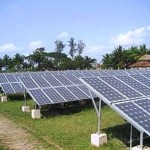
Mumbai – State Bank of India (SBI) has been undertaking several environmentally and socially sustainable initiatives through its 14000 plus branches spread across the length and breadth of the country, and was one of the few banks in the country to have enunciated a ‘Green Banking Policy’, as early as in 2007.
The Bank on February 21 became a signatory investor in the Carbon Disclosure Project (CDP), a collaboration of over 550 global institutional investors with assets under management of US $71 trillion.
“State Bank was the first in the entire Banking, Insurance and Financial Services sector to have conceptualized and owned wind farms for generation of green power to part substitute consumption of thermal power by its offices in India and we have already launched a project to measure and manage organization level foot print to achieve carbon neutrality,” said Shri O. P. Bhatt, Chairman, State Bank of India. “Partnering with CDP has only reiterated the Bank’s resolve and commitment towards sustainable development,” he said.
“We are delighted to welcome the financial powerhouse, State Bank of India, as a signatory. As much of the world’s economic recovery will now come from rapid growth in emerging economies like India, it was crucial for us to have a strong partner like the SBI to promote the truly global fight for sustainable development,” said Paul Simpson, CEO of CDP.
“We are pleased that State Bank of India has become a signatory, as this conveys a strong message to the Indian finance sector and the strategic role it can play in promoting a sustainable future,” said Ravi Singh, Secretary General and CEO of WWF-India.
Being a major bank in the country, SBI stands to become a great catalyst in encouraging the adoption of sustainable strategies by both – businesses and the financial sector. “We congratulate SBI on becoming a signatory to CDP; this is a very important milestone for the initiative in India,” said Seema Arora, Principal Counselor & Head of CII-ITC Centre of Excellence for Sustainable Development.
Each year, on behalf of signatory investors, the CDP collects climate change and carbon emissions data from over 5,000 large companies globally, which include the top 200 companies in India listed on the National Stock Exchange. Over 550 institutional investors – ranging from pension funds like TIAA-CREF and insurance companies like Allianz and Swiss Re through blue chip banks and asset managers such as Black Rock, HSBC, Goldman Sachs and Morgan Stanley – are signatories to the CDP.
In India, investors such as HDFC Bank Ltd., IDBI, IDFC, Reliance Capital, Tata Capital, IndusInd Bank and Yes Bank have also become signatories. CDP sends an annual letter and questionnaire on behalf of these financial institutions to the top 200 Indian companies by market capitalization. In 2010, 51 Indian companies responded to the questionnaire. In the disclosure, Indian companies reported on their carbon emissions data, reduction targets, associated risks and opportunities and increasing board level managerial resources in spearheading the execution of climate change strategies within their organizations.
- Compared to the 62% in 2009, 85% of the companies disclosed their GHG emissions in 2010.
- Although in total only 10 companies disclosed monetary savings as a result of their actions, the reported amount stands at a staggering Rs. 393.3 crores (~US $ 85 million), with emissions reductions of 6.2 million metric tonnes of CO2e per year.
About Investor CDP
In 2010, over 2,000 global companies reported on their climate strategies, GHG emissions and energy use, including 82% of the top 500 companies in the FTSE Global Equity Series Index. From February 1st 2011, the Investor CDP information request will be sent out to more than 5,000 companies in over 30 major economies in both developed and emerging markets.
A recent study revealed that the world’s top 3,000 companies, by market capitalization, were responsible for environmental damages worth US $ 2.15 trillion, in 2008, covering water and air pollution, greenhouse gas emissions, general waste and depleted resources. These external costs caused by companies can reduce returns to investors: “For a diversified investor, environmental costs are unavoidable as they come back into the portfolio as insurance premiums, taxes, inflated input prices and the physical cost associated with disasters. These costs could also reduce future cash flows and dividends. Ultimately, externalities caused by companies could significantly affect the value of capital markets, or their potential for growth, and with that, the value of diversified portfolios,” according to a report of the UNEP’s Financial Initiative.
CDP provides investors, insurance companies and banks with a lens through which to evaluate these externalities and how they will impact their specific portfolio.
State Bank of India
As a responsible Corporate Citizen, the Bank has always been in the forefront and has been undertaking various initiatives through its Community Services Banking towards welfare of the society as a whole. Be it tree plantation or adoption of a girl child, engaging with various NGOs to facilitate education or providing medical & other services to the underprivileged, or helping in any other social cause, the Bank through its vast network of about 14000 plus branches has been participating wholeheartedly in supporting these causes.
The issues of Global Warming and Climate Change have also not escaped the attention of the Bank. It was as early as in 2007 when a formal Green Banking Policy was laid down by the Bank. And since then the Bank has been endeavouring for reduction of its carbon footprint by urging its vast network of branches and other establishments to adopt several measures to this end, including energy efficient lighting systems, installation of energy savers, water harvesting and efficient water and waste management systems, gradual migration to paperless banking, plantation of fruit bearing trees, etc. Moreover, with a view to sensitizing all its staff members, the Bank has also introduced awareness modules in all its training programmes run in the various learning facilities all over the country.







